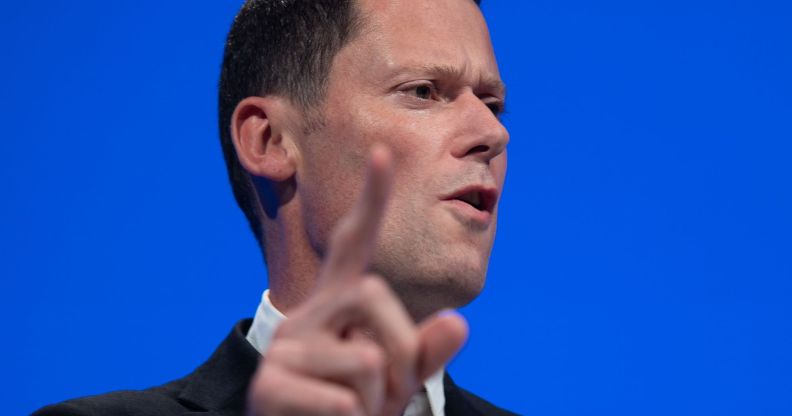This straight, white Tory politician has strong opinions on what Pride flag should be flown in the UK

Alex Chalk seems to have a lot of opinions about which Pride flags actually represent the community. (Getty)
The secretary of state for justice has written that he thinks the Pride Progress flag is not the “correct” flag to use to support the LGBTQ+ community.
The conservative MP and lord chancellor, Alex Chalk – who is married with two children, published a letter on Monday (20 November) directed towards Don Valley MP Nick Fletcher in which he reprimanded a set of prisons for raising the flag in support of its LGBTQ+ staff.
Chalk specifically criticised HMP Pentonville and HMP Wandsworth for using the Progress Pride flag, which he said “was to show support for the LGBT+ community” but said he believed the choice of flag “was not the correct one in this instance.”
“The six-strip ‘Rainbow flag’ is one of the flags authorised to be flown should an establishment wish to do so, but this permission does not extend to any other representative versions,” Chalk wrote.
He then added both HMP Pentonville and HMP Wandsworth had been ordered to remove the flags and would “remind all our institutions” of the rules around flying flags.
Fletcher claimed in a post commenting on the letter that the Progress flag “promoted the idea you can be born in the wrong body,” and added that he believed “you can’t.”
He added that “much more work is needed” to remove what he described as the “influence of this ideology,” seemingly referring to the existence of trans and non-binary people.
The Tory MP has been obsessed with removing the rights of trans people over the past few years, including plans to remove pronouns from schools entirely, claiming that they were “confusing people.”
What does the Progress Pride flag actually stand for?
Despite what Nick Fletcher may claim, the idea that the Progress Pride flag promotes the notion of being born in the wrong body is not true and it never has been.
Created in 2018 by designer Daniel Quasar, the flag incorporates a chevron featuring black, brown, light blue, pink and white stripes to signify support for the trans community and marginalised people of colour.
Since not all trans and non-binary people subscribe to the idea of being “born into the wrong body,” the idea that the flag specifically represents that idea is false.
The design has gone through several iterations over the last few years, with an updated version in 2021 adding recognition for intersex people.
While the majority of LGBTQ+ supportive people have no issue with the flag, its use has become a sticking-point for anti-trans debates on vaguely defined “ideology” which typically means accepting that trans and non-binary people, in fact, exist.
‘Gender critical’ pundits have particularly taken issue with the flag, saying that it is a symbol of a group that wants to erase lesbians and women which, again, is false.

